2011 INFINITI QX56 Wiring
[x] Cancel search: WiringPage 4324 of 5598
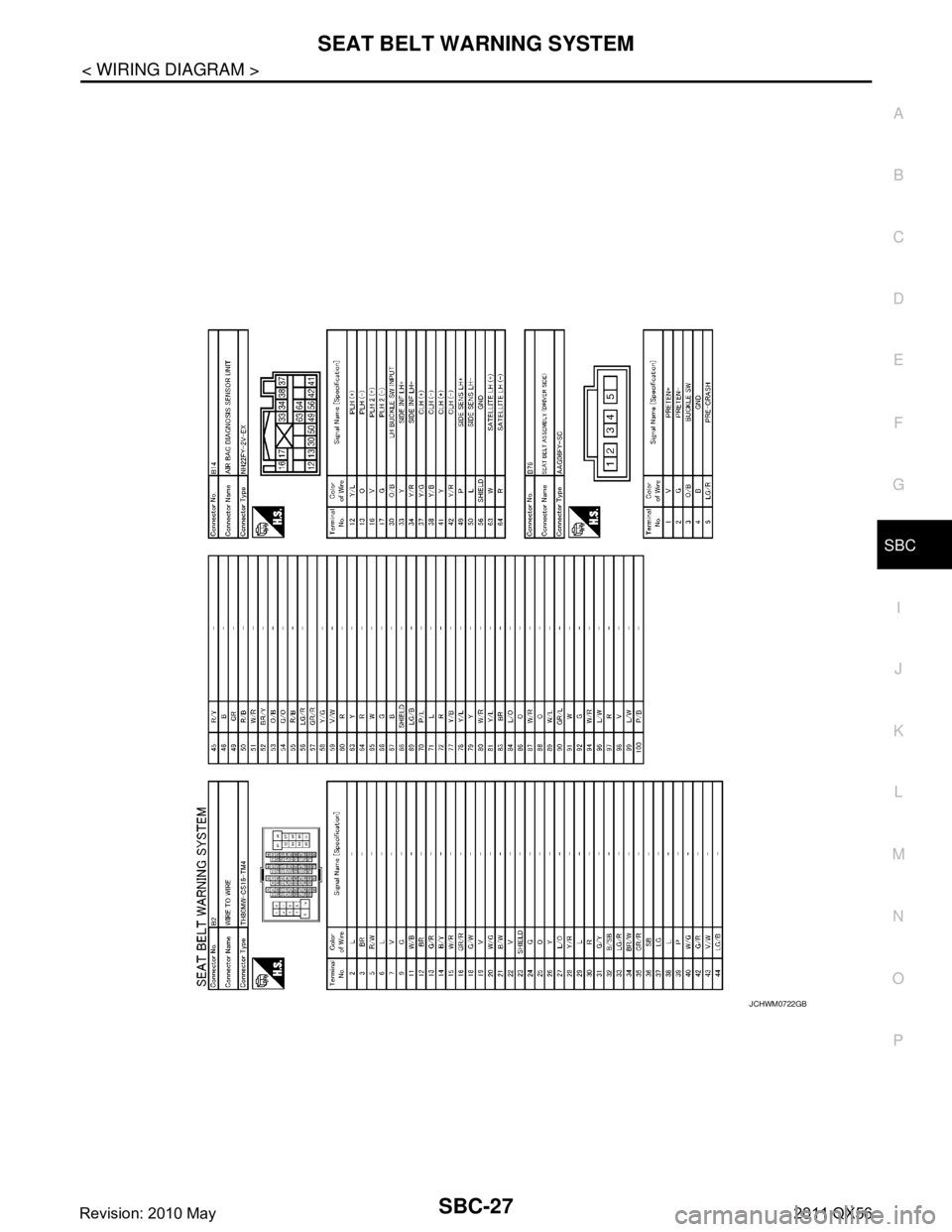
SEAT BELT WARNING SYSTEMSBC-27
< WIRING DIAGRAM >
C
DE
F
G
I
J
K L
M A
B
SBC
N
O P
JCHWM0722GB
Revision: 2010 May2011 QX56
Page 4325 of 5598
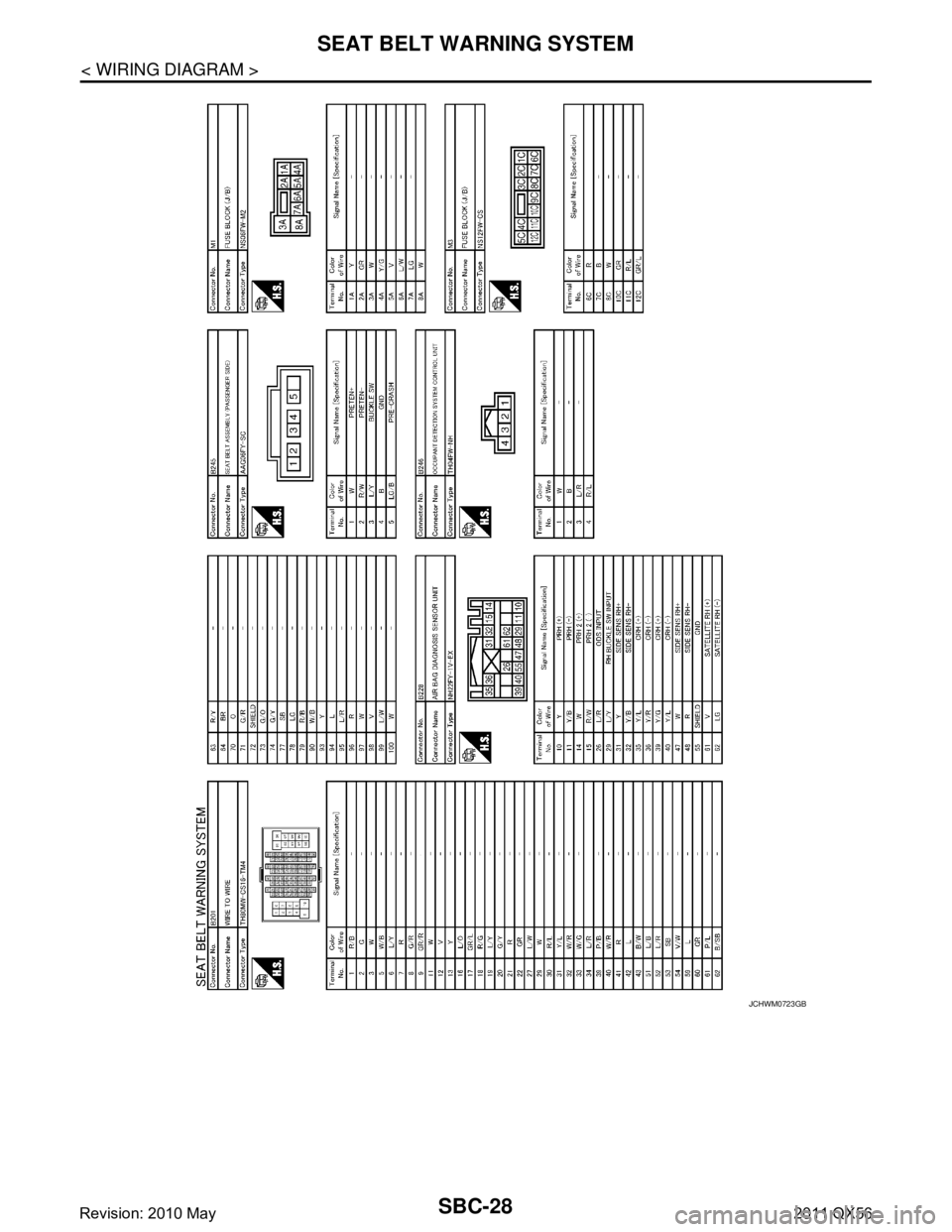
SBC-28
< WIRING DIAGRAM >
SEAT BELT WARNING SYSTEM
JCHWM0723GB
Revision: 2010 May2011 QX56
Page 4326 of 5598
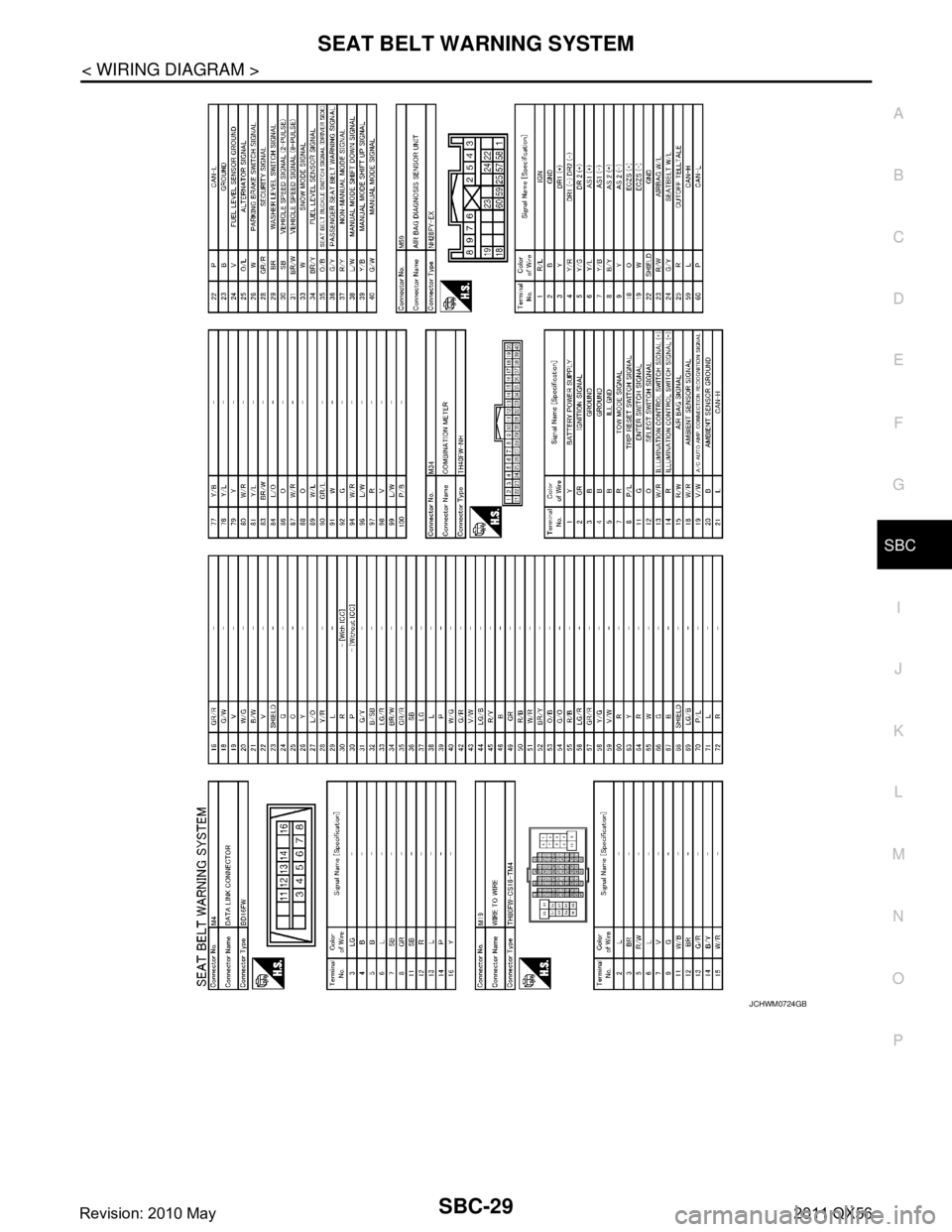
SEAT BELT WARNING SYSTEMSBC-29
< WIRING DIAGRAM >
C
DE
F
G
I
J
K L
M A
B
SBC
N
O P
JCHWM0724GB
Revision: 2010 May2011 QX56
Page 4327 of 5598
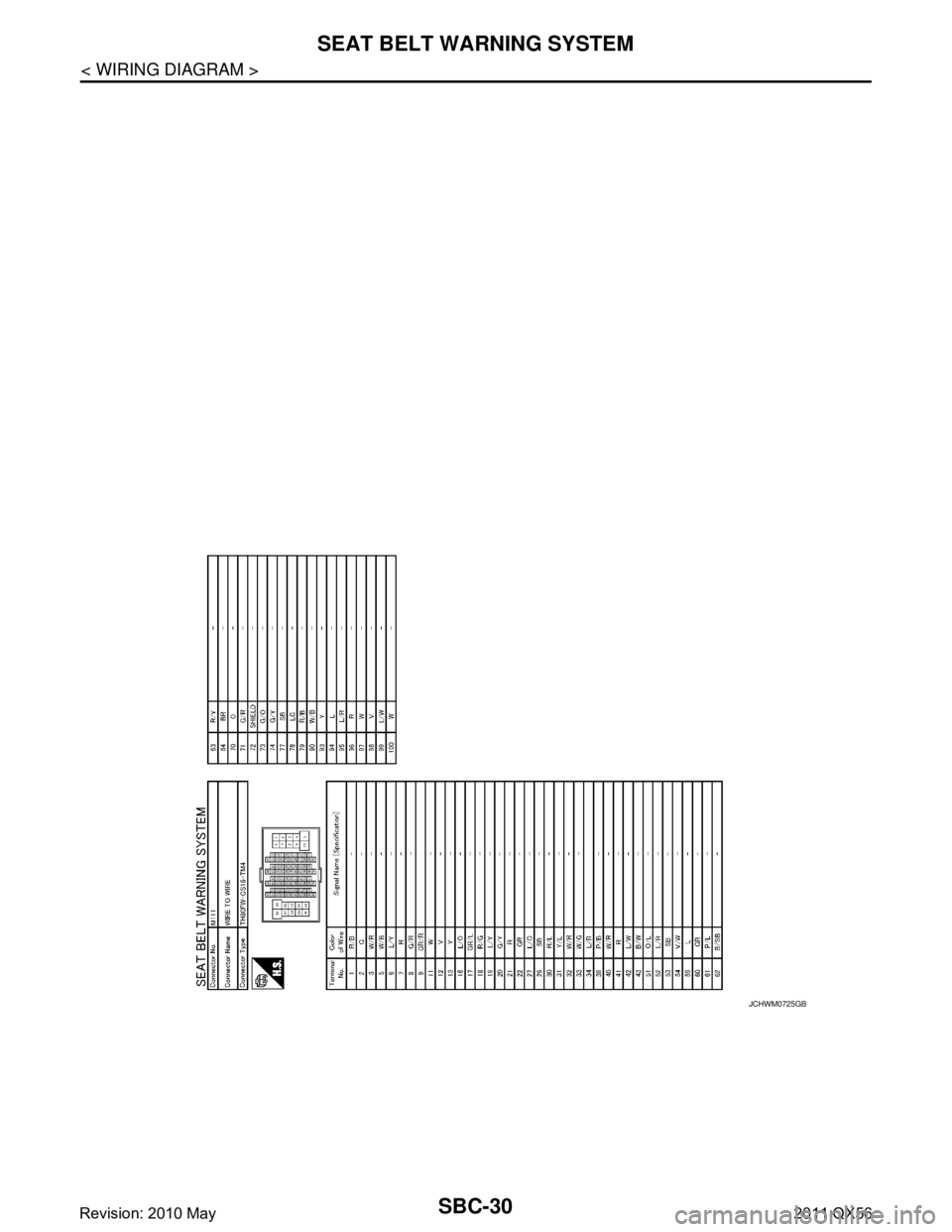
SBC-30
< WIRING DIAGRAM >
SEAT BELT WARNING SYSTEM
JCHWM0725GB
Revision: 2010 May2011 QX56
Page 4332 of 5598
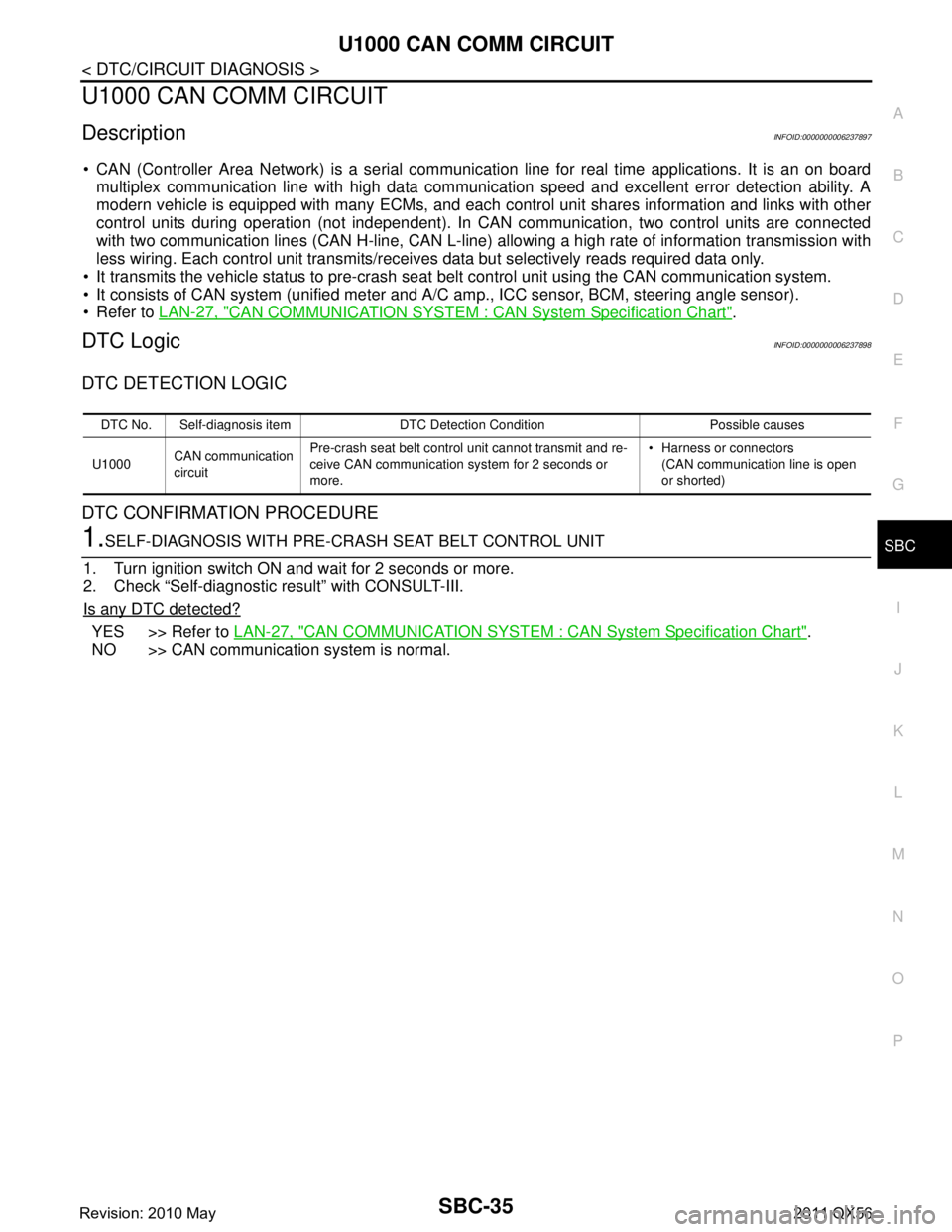
U1000 CAN COMM CIRCUITSBC-35
< DTC/CIRCUIT DIAGNOSIS >
C
DE
F
G
I
J
K L
M A
B
SBC
N
O P
U1000 CAN COMM CIRCUIT
DescriptionINFOID:0000000006237897
CAN (Controller Area Network) is a serial communica tion line for real time applications. It is an on board
multiplex communication line with high data communication speed and excellent error detection ability. A
modern vehicle is equipped with many ECMs, and each cont rol unit shares information and links with other
control units during operation (not independent). In CA N communication, two control units are connected
with two communication lines (CAN H-line, CAN L-line) allowing a high rate of information transmission with
less wiring. Each control unit transmits/receive s data but selectively reads required data only.
It transmits the vehicle status to pre-crash seat belt control unit using the CAN communication system.
It consists of CAN system (unified meter and A/ C amp., ICC sensor, BCM, steering angle sensor).
Refer to LAN-27, "
CAN COMMUNICATION SYSTEM : CA N System Specification Chart".
DTC LogicINFOID:0000000006237898
DTC DETECTION LOGIC
DTC CONFIRMATION PROCEDURE
1.SELF-DIAGNOSIS WITH PRE-CRASH SEAT BELT CONTROL UNIT
1. Turn ignition switch ON and wait for 2 seconds or more.
2. Check “Self-diagnostic result” with CONSULT-III.
Is any DTC detected?
YES >> Refer to LAN-27, "CAN COMMUNICATION SYSTEM : CA N System Specification Chart".
NO >> CAN communication system is normal.
DTC No. Self-diagnosis item DTC Detection Condition Possible causes
U1000 CAN communication
circuit Pre-crash seat belt control unit cannot transmit and re-
ceive CAN communication system for 2 seconds or
more. Harness or connectors
(CAN communication line is open
or shorted)
Revision: 2010 May2011 QX56
Page 4362 of 5598

SCS-2
ACCUMULATOR ......................................................34
ACCUMULATOR : Exploded View .........................35
ACCUMULATOR : Removal and Installation ..........35
ACCUMULATOR : Inspection ................................38
ACCUMULATOR : Disposal ...................................38
PPMU, MIDDLE TUBE ASSEMBLY, PPMU PIPE ...38
PPMU, MIDDLE TUBE ASSEMBLY, PPMU PIPE
: Exploded View ......................................................
39
PPMU, MIDDLE TUBE ASSEMBLY, PPMU PIPE
: Removal and Installation ......................................
39
PPMU, MIDDLE TUBE ASSEMBLY, PPMU PIPE
: Inspection .............................................................
43
PPMU, MIDDLE TUBE ASSEMBLY, PPMU PIPE
: Disposal ................................................................
43
REAR TUBE ASSEMBLY ...................................... ...43
REAR TUBE ASSEMBLY : Exploded View ............44
REAR TUBE ASSEMBLY : Removal and Installa-
tion ....................................................................... ...
44
REAR TUBE ASSEMBLY : Inspection ...................46
AIR LEVELIZER CONTROL SYSTEM
PRECAUTION ....... ....................... ...............
47
PRECAUTIONS .............................................. ...47
Precaution for Supplemental Restraint System
(SRS) "AIR BAG" and "SEAT BELT PRE-TEN-
SIONER" .............................................................. ...
47
Precaution Necessary for Steering Wheel Rota-
tion after Battery Disconnect ..................................
47
Precaution for Procedure without Cowl Top Cover ...48
Precaution for Air Levelizer Control System ...........48
SYSTEM DESCRIPTION ............................49
DESCRIPTION ................................................ ...49
Description ........................................................... ...49
COMPONENT PARTS .......................................50
Component Parts Location .................................. ...50
Component Description ..........................................50
Air Levelizer Control Module ..................................51
Vehicle Height Sensor ............................................51
Air Compressor .......................................................51
Air Compressor Relay ............................................51
CK SUSP Indicator Lamp .......................................51
STRUCTURE AND OPERATION ......................52
Rear Shock Absorber .......................................... ...52
Vehicle Height Sensor ............................................53
SYSTEM .......................................................... ...54
System Diagram .................................................. ...54
System Description .................................................54
Fail-safe ..................................................................55
DIAGNOSIS SYSTEM (AIR LEVELIZER
CONTROL MODULE) ........................................
56
CONSULT-III Function ........................................ ...56
ECU DIAGNOSIS INFORMATION .............58
AIR LEVELIZER CONTROL MODULE .......... ...58
Reference Value .................................................. ...58
Fail-safe ..................................................................59
DTC Inspection Priority Chart .................................59
DTC Index ...............................................................59
WIRING DIAGRAM ....................................61
AIR LEVELIZER CONTROL SYSTEM ........... ...61
Wiring Diagram .................................................... ...61
BASIC INSPECTION ..................................65
DIAGNOSIS AND REPAIR WORKFLOW ...... ...65
Work Flow ............................................................ ...65
Diagnostic Work Sheet ...........................................66
STANDARD VEHICLE HEIGHT SETTING .......67
Description ........................................................... ...67
Work Procedure ......................................................67
DTC/CIRCUIT DIAGNOSIS ........................69
C1801 VHCL HEIGHT SENSOR .................... ...69
DTC Logic ............................................................ ...69
Diagnosis Procedure ..............................................69
Component Inspection ............................................70
C1802 AIR SUS COMPRS RELAY ...................72
DTC Logic ............................................................ ...72
Diagnosis Procedure ..............................................72
C1803 AIR SUSPENSION EXH SOL ................74
DTC Logic ............................................................ ...74
Diagnosis Procedure ..............................................74
Component Inspection ............................................75
C1804 VHCL HEIGHT ADJ UP .........................77
DTC Logic ............................................................ ...77
Diagnosis Procedure ..............................................77
Component Inspection (Air Compressor Relay) .....79
Component Inspection (Air Compressor) ............. ...79
C1805 VHCL HEIGHT ADJ DOWN ...................80
DTC Logic ............................................................ ...80
Diagnosis Procedure ..............................................80
C1806 VHCL HEIGHT SEN FIX ........................81
DTC Logic ............................................................ ...81
Diagnosis Procedure ...............................................81
C1807 VHCL HEIGHT SEN VOLT ....................82
DTC Logic ............................................................ ...82
Diagnosis Procedure ..............................................82
C1808 AIR SUS COMPRS FNCTN ...................84
DTC Logic ............................................................ ...84
Diagnosis Procedure ..............................................84
U1000 CAN COMM CIRCUIT ............................87
Revision: 2010 May2011 QX56
Page 4364 of 5598
![INFINITI QX56 2011 Factory Service Manual
SCS-4
< PRECAUTION >[HBMC]
PRECAUTIONS
PRECAUTION
PRECAUTIONS
Precaution for Supplemental Restraint S
ystem (SRS) "AIR BAG" and "SEAT BELT
PRE-TENSIONER"
INFOID:0000000006256134
The Supplemental Res INFINITI QX56 2011 Factory Service Manual
SCS-4
< PRECAUTION >[HBMC]
PRECAUTIONS
PRECAUTION
PRECAUTIONS
Precaution for Supplemental Restraint S
ystem (SRS) "AIR BAG" and "SEAT BELT
PRE-TENSIONER"
INFOID:0000000006256134
The Supplemental Res](/manual-img/42/57033/w960_57033-4363.png)
SCS-4
< PRECAUTION >[HBMC]
PRECAUTIONS
PRECAUTION
PRECAUTIONS
Precaution for Supplemental Restraint S
ystem (SRS) "AIR BAG" and "SEAT BELT
PRE-TENSIONER"
INFOID:0000000006256134
The Supplemental Restraint System such as “A IR BAG” and “SEAT BELT PRE-TENSIONER”, used along
with a front seat belt, helps to reduce the risk or severi ty of injury to the driver and front passenger for certain
types of collision. This system includes seat belt switch inputs and dual stage front air bag modules. The SRS
system uses the seat belt switches to determine the front air bag deployment, and may only deploy one front
air bag, depending on the severity of a collision and w hether the front occupants are belted or unbelted.
Information necessary to service the system safely is included in the “SRS AIR BAG” and “SEAT BELT” of this
Service Manual.
WARNING:
• To avoid rendering the SRS inopera tive, which could increase the risk of personal injury or death in
the event of a collision that would result in air bag inflation, all maintenance must be performed by
an authorized NISS AN/INFINITI dealer.
Improper maintenance, including in correct removal and installation of the SRS, can lead to personal
injury caused by unintent ional activation of the system. For re moval of Spiral Cable and Air Bag
Module, see the “SRS AIR BAG”.
Do not use electrical test equipmen t on any circuit related to the SRS unless instructed to in this
Service Manual. SRS wiring harnesses can be identi fied by yellow and/or orange harnesses or har-
ness connectors.
PRECAUTIONS WHEN USING POWER TOOLS (AIR OR ELECTRIC) AND HAMMERS
WARNING:
When working near the Air Bag Diagnosis Sensor Unit or other Air Bag System sensors with the ignition ON or engine running, DO NOT use air or electric power tools or strike near the sensor(s)
with a hammer. Heavy vibration could activate the sensor(s) and deploy the air bag(s), possibly
causing serious injury.
When using air or electric power tools or hammers , always switch the ignition OFF, disconnect the
battery, and wait at least 3 minu tes before performing any service.
Precaution Necessary for Steering W heel Rotation after Battery Disconnect
INFOID:0000000006256136
NOTE:
Before removing and installing any control units, first tu rn the push-button ignition switch to the LOCK posi-
tion, then disconnect bot h battery cables.
After finishing work, confirm that all control unit connectors are connected properly, then re-connect both
battery cables.
Always use CONSULT-III to perform self-diagnosis as a part of each function inspection after finishing work.
If a DTC is detected, perform trouble diagnos is according to self-diagnosis results.
For vehicle with steering lock unit, if the battery is disconnected or discharged, the steering wheel will lock and
cannot be turned.
If turning the steering wheel is required with the bat tery disconnected or discharged, follow the operation pro-
cedure below before starting the repair operation.
OPERATION PROCEDURE
1. Connect both battery cables. NOTE:
Supply power using jumper cables if battery is discharged.
2. Turn the push-button ignition switch to ACC position. (At this time, the steering lock will be released.)
3. Disconnect both battery cables. The steering lock wi ll remain released with both battery cables discon-
nected and the steering wheel can be turned.
4. Perform the necessary repair operation.
Revision: 2010 May2011 QX56
Page 4407 of 5598
![INFINITI QX56 2011 Factory Service Manual
PRECAUTIONSSCS-47
< PRECAUTION > [AIR LEVELIZER CONTROL SYSTEM]
C
D
F
G H
I
J
K L
M A
B
SCS
N
O P
PRECAUTION
PRECAUTIONS
Precaution for Supplemental Restraint System (SRS) "AIR BAG" and "SEAT BELT
INFINITI QX56 2011 Factory Service Manual
PRECAUTIONSSCS-47
< PRECAUTION > [AIR LEVELIZER CONTROL SYSTEM]
C
D
F
G H
I
J
K L
M A
B
SCS
N
O P
PRECAUTION
PRECAUTIONS
Precaution for Supplemental Restraint System (SRS) "AIR BAG" and "SEAT BELT](/manual-img/42/57033/w960_57033-4406.png)
PRECAUTIONSSCS-47
< PRECAUTION > [AIR LEVELIZER CONTROL SYSTEM]
C
D
F
G H
I
J
K L
M A
B
SCS
N
O P
PRECAUTION
PRECAUTIONS
Precaution for Supplemental Restraint System (SRS) "AIR BAG" and "SEAT BELT
PRE-TENSIONER"
INFOID:0000000006256135
The Supplemental Restraint System such as “A IR BAG” and “SEAT BELT PRE-TENSIONER”, used along
with a front seat belt, helps to reduce the risk or severi ty of injury to the driver and front passenger for certain
types of collision. This system includes seat belt switch inputs and dual stage front air bag modules. The SRS
system uses the seat belt switches to determine the front air bag deployment, and may only deploy one front
air bag, depending on the severity of a collision and whether the front occupants are belted or unbelted.
Information necessary to service the system safely is included in the “SRS AIR BAG” and “SEAT BELT” of this
Service Manual.
WARNING:
To avoid rendering the SRS inoper ative, which could increase the risk of personal injury or death in
the event of a collision that would result in air ba g inflation, all maintenance must be performed by
an authorized NISSAN/INFINITI dealer.
Improper maintenance, including in correct removal and installation of the SRS, can lead to personal
injury caused by unintentional act ivation of the system. For removal of Spiral Cable and Air Bag
Module, see the “SRS AIR BAG”.
Do not use electrical test equipm ent on any circuit related to the SRS unless instructed to in this
Service Manual. SRS wiring harnesses can be identi fied by yellow and/or orange harnesses or har-
ness connectors.
PRECAUTIONS WHEN USING POWER TOOLS (AIR OR ELECTRIC) AND HAMMERS
WARNING:
When working near the Air Bag Diagnosis Sensor Unit or other Air Bag System sensors with the
ignition ON or engine running, DO NOT use air or electric power tools or strike near the sensor(s)
with a hammer. Heavy vibration could activate the sensor(s) and deploy the air bag(s), possibly
causing serious injury.
When using air or electric power tools or hammers , always switch the ignition OFF, disconnect the
battery, and wait at least 3 minutes before performing any service.
Precaution Necessary for Steering Wh eel Rotation after Battery Disconnect
INFOID:0000000006256137
NOTE:
Before removing and installing any control units, first tu rn the push-button ignition switch to the LOCK posi-
tion, then disconnect both battery cables.
After finishing work, confirm that all control unit connectors are connected properly, then re-connect both
battery cables.
Always use CONSULT-III to perform self-diagnosis as a part of each function inspection after finishing work.
If a DTC is detected, perform trouble diagnos is according to self-diagnosis results.
For vehicle with steering lock unit, if the battery is disconnected or discharged, the steering wheel will lock and
cannot be turned.
If turning the steering wheel is required with the batte ry disconnected or discharged, follow the operation pro-
cedure below before starting the repair operation.
OPERATION PROCEDURE
1. Connect both battery cables. NOTE:
Supply power using jumper cables if battery is discharged.
2. Turn the push-button ignition switch to ACC position. (At this time, the steering lock will be released.)
3. Disconnect both battery cables. The steering lock wil l remain released with both battery cables discon-
nected and the steering wheel can be turned.
4. Perform the necessary repair operation.
Revision: 2010 May2011 QX56